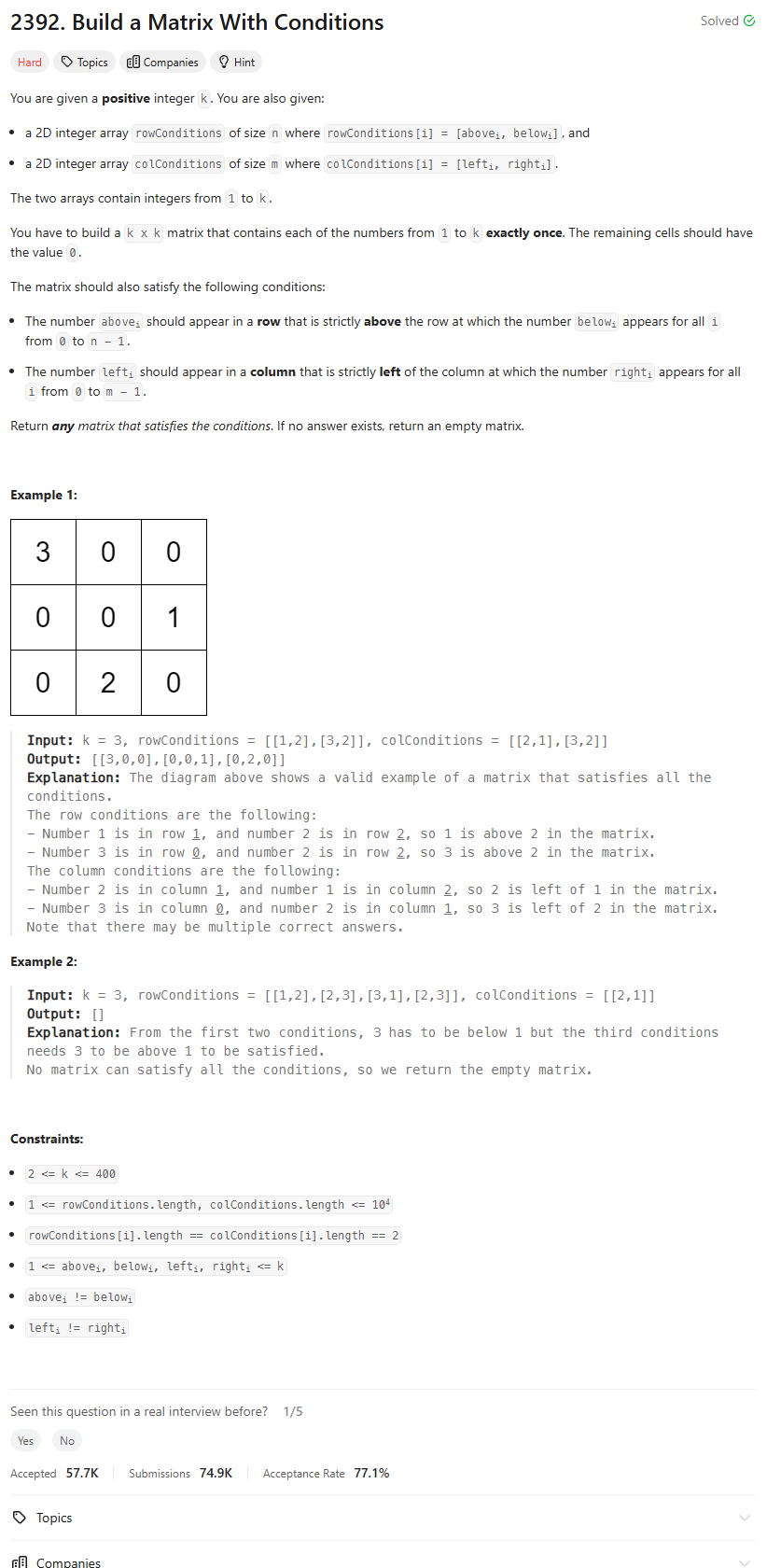Problem of The Day: Build a Matrix With Conditions
Problem Statement

Intuition
To solve this problem, the key insight is to perform topological sorting on the given row and column conditions. Topological sorting helps us determine the order in which elements should appear based on their dependencies.
Approach
-
Topological Sort:
- Perform topological sorting on the
rowConditionsto determine the order of rows. - Perform topological sorting on the
colConditionsto determine the order of columns. - If a cycle is detected during the sorting process, return an empty matrix since it’s impossible to satisfy the given conditions.
- Perform topological sorting on the
-
Matrix Construction:
- Use the results of the topological sorts to map each element to its respective row and column.
- Create an empty matrix of size
k x k. - Place each element in the matrix according to the determined row and column positions.
Complexity
-
Time Complexity:
- Topological sort involves visiting each node and edge, giving a complexity of (O(V + E)), where (V) is the number of vertices (in this case, (k)) and (E) is the number of edges (given by
rowConditionsandcolConditions). - Thus, the overall time complexity is (O(k + \text{len(rowConditions)} + \text{len(colConditions)})).
- Topological sort involves visiting each node and edge, giving a complexity of (O(V + E)), where (V) is the number of vertices (in this case, (k)) and (E) is the number of edges (given by
-
Space Complexity:
- Storing the adjacency list requires (O(k + \text{len(rowConditions)} + \text{len(colConditions)})).
- Additionally, storing the matrix requires (O(k^2)).
- Therefore, the overall space complexity is (O(k^2 + \text{len(rowConditions)} + \text{len(colConditions)})).
Code
Code from NeetCodeIO
class Solution:
def buildMatrix(self, k: int, rowConditions: List[List[int]], colConditions: List[List[int]]) -> List[List[int]]:
def dfs(src, adj, visited, path, order):
if src in path:
return False
if src in visited:
return True
visited.add(src)
path.add(src)
for nei in adj[src]:
if not dfs(nei, adj, visited, path, order):
return False
path.remove(src)
order.append(src)
return True
def topological_sort(edges):
adj = defaultdict(list)
for src, dst in edges:
adj[src].append(dst)
visited, path = set(), set()
order = []
for src in range(1, k + 1):
if not dfs(src, adj, visited, path, order):
return []
return order[::-1]
def build_matrix():
row_order = topological_sort(rowConditions)
col_order = topological_sort(colConditions)
if not row_order or not col_order:
return []
val_to_row = {n: i for i, n in enumerate(row_order)}
val_to_col = {n: i for i, n in enumerate(col_order)}
mat = [[0] * k for _ in range(k)]
for num in range(1, k + 1):
r, c = val_to_row[num], val_to_col[num]
mat[r][c] = num
return mat
return build_matrix()
Editorial
Approach 1: Depth-First Search
class Solution:
def buildMatrix(
self,
k: int,
rowConditions: List[List[int]],
colConditions: List[List[int]],
) -> List[List[int]]:
# Store the topologically sorted sequences.
order_rows = self.__topoSort(rowConditions, k)
order_columns = self.__topoSort(colConditions, k)
# If no topological sort exists, return empty array.
if not order_rows or not order_columns:
return []
matrix = [[0] * k for _ in range(k)]
pos_row = {num: i for i, num in enumerate(order_rows)}
pos_col = {num: i for i, num in enumerate(order_columns)}
for num in range(1, k + 1):
if num in pos_row and num in pos_col:
matrix[pos_row[num]][pos_col[num]] = num
return matrix
def __topoSort(self, edges: List[List[int]], n: int) -> List[int]:
adj = defaultdict(list)
order = []
visited = [0] * (n + 1)
has_cycle = [False]
# Build adjacency list
for x, y in edges:
adj[x].append(y)
# Perform DFS for each node
for i in range(1, n + 1):
if visited[i] == 0:
self.__dfs(i, adj, visited, order, has_cycle)
# Return empty if cycle detected
if has_cycle[0]:
return []
# Reverse to get the correct order
order.reverse()
return order
def __dfs(
self,
node: int,
adj: defaultdict,
visited: List[int],
order: List[int],
has_cycle: List[bool],
):
# Mark node as visiting
visited[node] = 1
for neighbor in adj[node]:
if visited[neighbor] == 0:
self.__dfs(neighbor, adj, visited, order, has_cycle)
# Early exit if a cycle is detected
if has_cycle[0]:
return
elif visited[neighbor] == 1:
# Cycle detected
has_cycle[0] = True
return
# Mark node as visited
visited[node] = 2
# Add node to the order
order.append(node)